Studies
The first "Diving Management Study" was written to address client
inquiries and to justify specific safety procedures outlined in the
manuals. Since then, the concept has evolved to discuss various safety
issues, and most of these studies have gradually been adopted by
teams involved in underwater operations as well as by scientists, as
can be seen in the two documents below, which can be taken as
examples (note that the references cited by the authors are listed at
the end of their papers).

CCO Ltd
52/2 moo 2 tambon Tarpo 65000 Phitsanulock - THAILAND
Email: info@ccoLtd.co.th Phone: +66 857 277 123
This document discusses the problems posed by the
organization of continuous diving and the limits of
such operations. It defines this procedure, along with a
comparison of the methods of decompression, the
evaluation of additional equipment necessary to
implement it, and elements for determining when it is
economically realistic. Additionally, it includes a
summary of acceptable and unacceptable technical
solutions.
- Study CCO Ltd No 1 “Organize air & nitrox continuous diving
operations”
- Study CCO Ltd No 2 “Organize the maintenance of diving
cylinders”
This document discusses incident reports related to diving
cylinders and provides balanced solutions to prevent them
by describing the fabrication of these cylinders, along with
the types of valves and threads encountered, as well as
inspection procedures and a comprehensive description
of the main standards applicable to such equipment.
- Study CCO Ltd No 3 “Implement a drug and alcohol abuse policy”
This paper describes the various categories of drugs
encountered. It discusses the problems they may create
within a company, in addition to those that may arise from
the multiple legislations in force. Additionally, it suggests
solutions promoted by medical specialists to address the
problem and ensure that such substances are banned
from any workplace through the proactive vigilance of
personnel.
- Study CCO Ltd No 4 “Strengthen the US Navy saturation diving
procedures”
This study suggests reinforcements based on scientific
publications and practices from recognized, competent
bodies to enhance the US Navy saturation procedures,
without affecting their fundamental calculations, thereby
ensuring compliance with legal limits and providing a
decompression procedure that is safer and better adapted
to personnel involved in underwater work.
- Study CCO Ltd No 5 “Implement NORMAM-15/DPC-2011 saturation
diving procedures (Today Normam222/DPC)”
The COMEX-based NORMAM-15/DPC-2011 saturation
procedures, adopted by the Brazilian Navy Directorate of
Ports and Coasts in June 2011, are an evolution of the
previously published COMEX MT-92 procedures, which
remain in force under French regulations.
In addition to closely following the original COMEX
procedures, this study incorporates several improvements
to diving protocols adopted by the industry since the
official release of these decompression procedures in
2011. This has resulted in a safe, cost-free alternative to
recent saturation procedures, which has been favorably
received by several scientists and companies, cited as a
reference in recent scientific studies, and frequently
downloaded.
- Study CCO Ltd No 6 “A Novel Method for Estimating Diver
Umbilical Length in Dynamic Positioning (DP) Vessel Operations”.
This document suggests methods to address issues that
IMCA and ADCI guidelines do not account in the
calculations they promote for the calculation of umbilical
lengths when diving from a dynamic positioning vessel,
such as variations in the draft of the diving support vessel,
eccentrically rotating azimuth thrusters, and the impact of
currents or sudden loss of position on the bell’s location.
- Study CCO Ltd No 7 “History and evaluation of IMCA D 050 rev. 1 -
Minimum quantities of gas requiered offshore.”
IMCA recently published an update of the diving
guidance D 050 “Minimum quantities of gas required
offshore”. This was an opportunity to recall the purpose
of these guidelines and their evolution since their initial
publication by AODC in July 1983. It was also an
opportunity to assess whether this new revision
enhances the previous one and is suitable for
commercial diving operations.
- Study CCO Ltd No 8 “Set a policy for electronic devices in
chambers”
This study proposes balanced solutions for the use of
electronic devices in hyperbaric chambers, based on a
survey conducted by QinetiQ, a company specializing in
safety and defense industries, and practices commonly
applied in the air transportation industry, which faces
similar risks from these devices that may lead to
catastrophic events during any flight. Reports from the
diving industry are analyzed alongside those from air
safety organizations to provide the suggested solutions.
- Study CCO Ltd No 9 “Analysis of the document IOGP 411 rev. 2021
- Recommended practices for diving operations”
IOGP is an association that groups numerous oil and gas
producers, aiming to act as a pressure group towards
governments to impose its point of view and practices. It
refreshed its diving guidelines in 2021 with the aim of
imposing them as the sole guidelines to be used in the
offshore industry.
This study assesses whether the revised guidelines,
provided by this organization, merit consideration as a
reference, as suggested by their authors.
- Study CCO Ltd No 10 “working at height during the mobilization
and the maintenance of diving and ROV systems”
This document has been created in response to reports
showing that numerous mistakes are made regarding
work at height during the mobilization and the
maintenance of diving and ROV systems. It aims not to
create new guidelines but to promote those from
competent bodies that the author considers relevant.

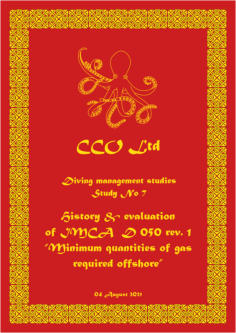

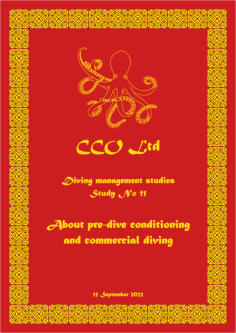
- Study CCO Ltd No 11 “About pre-dive conditioning and commercial
diving”
“Pre-dive conditioning” refers to experimental studies
conducted to demonstrate that preparing the diver
through exercises, oxygen, substance uptake, or other
methods before immersion has beneficial effects on
decompression.
This document provides a brief review of experiments
conducted and the applicability of the tested procedures
to the commercial diving industry. It also highlights the
lack of means devoted to scientists and suggests possible
actions that commercial diving companies could
implement to support research.
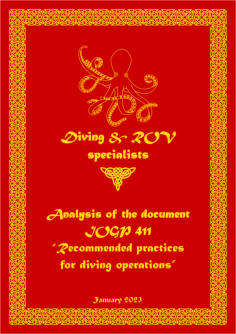
- Study CCO Ltd No 12 “Aout standards”
This study is the PDF version of an article called “About
standards”, published under HTML format on the website
“Diving and ROV Specialists.com”.
It briefly describes the function and origins of standards,
the methods used by unethical pressure groups to
deviate from them for their profit, and how various
ethical organizations can organize to counter these
pressure groups.

- Document Diving & ROV Specialists “Description of a saturation
diving system”.
This document provides a comprehensive description of a
saturation diving system and outlines the management
system necessary to maintain it and ensure its acceptance
by clients.
This description is based on two existing modern systems
fitted with equipment such as a diver monitoring system,
automatic oxygen injection system, and others.
In addition to the detailed description of the saturation
system, topics such as the Certification process, Failure
Mode and Effects Analysis (FMEA), Planned Maintenance
System, and audits are explained.
This document has been updated in August 2021

<
script
id
=
"_wau5vn"
>
var
_wau = _wau || []; _wau.
push
([
"dynamic"
,
"x23dgm2m2n"
,
"5vn"
,
"c4302bffffff"
,
"small"
]);
</
script
>
<
script
async
src
=
"//waust.at/d.js"
>
</
script
>


These studies are available for free and can be downloaded by
clicking on the images that represent their covers. They are also
published on the website “Diving and ROV specialists.com”.
Problems in selecting a decompression
table for commercial diving in Poland,
by Stanisław Skrzynski & Piotr
Siermontowski.
Review of saturation decompression
procedures used in commercial diving,
by Jean-Pierre Imbert, Lyubisa Matity,
Jean-Yves Massimelli, and Philip Bryson.
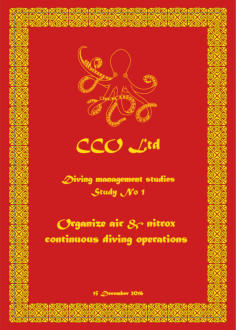
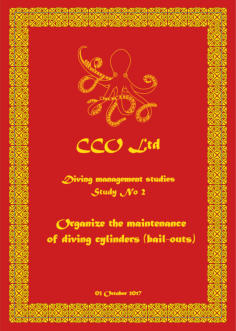


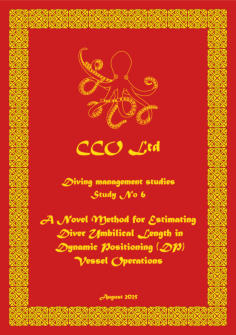
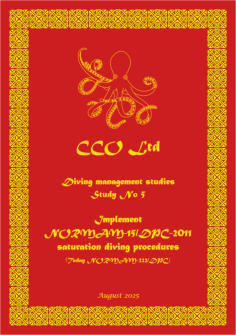
- Study CCO Ltd No 13 “Gap analysis of NORMAM-15/DPC-2011
saturation procedures with those of NORMAM-222/DPC”
This document compares the original NORMAM-15/DPC-
2011 saturation procedures from the Brazilian Navy with
the new NORMAM-222/DPC procedures published in
2023. The goal is to see if the new guidelines still follow
the original COMEX procedures or if changes have been
made.










